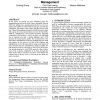10 search results - page 1 / 2 » Chinese Remaindering with Multiplicative Noise |
MST
2007
13 years 7 months ago
2007
We use lattice reduction to obtain a polynomial time algorithm for recovering an integer (up to a multiple) given multiples of its residues modulo sufficiently many primes, when t...
AICCSA
2005
IEEE
14 years 1 months ago
2005
IEEE
A new scheme for transmitting sensitive data is proposed, the proposed scheme depends on partitioning the output of a block encryption module using the Chinese Remainder Theorem a...
ACMSE
2007
ACM
13 years 11 months ago
2007
ACM
In this paper, we present two new centralized group key management protocols based on the Chinese Remainder Theorem (CRT). By shifting more computing load onto the key server we o...
ACSAC
2000
IEEE
13 years 12 months ago
2000
IEEE
The performance of RSA hardware is primarily determined by an efficient implementation of the long integer modular arithmetic and the ability to utilize the Chinese Remainder The...
APPT
2009
Springer
13 years 11 months ago
2009
Springer
We present the algorithm to multiply univariate polynomials with integer coefficients efficiently using the Number Theoretic transform (NTT) on Graphics Processing Units (GPU). The...

